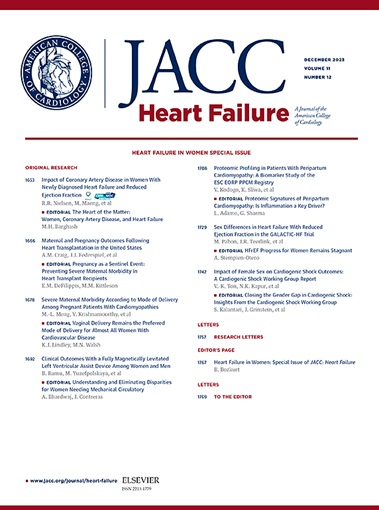直接面向医生的营销和对降低射血分数心力衰竭的最佳药物治疗的吸收。
IF 10.3
1区 医学
Q1 CARDIAC & CARDIOVASCULAR SYSTEMS
引用次数: 0
摘要
背景:针对心力衰竭伴射血分数降低的指导药物治疗(GDMT)仍未得到充分应用。直接面向医生的营销在加速GDMT吸收中的作用尚不清楚。目的:作者调查了医疗保险d部分下的行业营销餐和GDMT处方率之间的关系。作者将医疗保险数据集联系起来,以确定普通和晚期心力衰竭(AHF)心脏病专家在2019年至2021年期间对血管紧张素受体-neprilysin抑制剂(ARNIs)、钠-葡萄糖共转运蛋白2抑制剂(SGLT2is)、血管紧张素转换酶抑制剂、血管紧张素受体阻滞剂、矿皮质激素受体拮抗剂(MRAs)和β受体阻滞剂的处方。使用负二项回归分析,他们检查了销售膳食和已上市和未上市的GDMT处方率之间的关系。结果:在11,277名普通心脏病专家和329名AHF心脏病专家中,60%的人在2019年至2021年期间获得了ARNI的营销报酬,50%的人获得了SGLT2i的营销报酬。在普通心脏病专家中,而不是AHF心脏病专家中,2020年接触ARNI营销餐与2021年更大的ARNI处方量相关(1-4 ARNI餐;相对比值:1.43 [95% CI: 1.34-1.53];5-9 ARNI餐;相对比值:1.69 [95% CI: 1.48-1.93];≥10份ARNI餐;相对比值:2.09 [95% CI: 1.80-2.43])。SGLT2i的结果相似。GDMT其他支柱的营销和处方之间的关联在药物类别中是不一致的。ARNI和SGLT2i的营销均未与mra处方增加一致相关。结论:对普通心脏病专家的行业营销与ARNIs和SGLT2is的摄取增加有关,但与GDMT所有支柱的摄取增加无关。一旦多种通用制剂在美国上市,心力衰竭综合治疗的改进将需要其他机制来加速mra和β受体阻滞剂以及ARNIs和SGLT2is的吸收。本文章由计算机程序翻译,如有差异,请以英文原文为准。
Direct-to-Physician Marketing and Uptake of Optimal Medical Therapy for Heart Failure With Reduced Ejection Fraction
Background
Guideline-directed medical therapy (GDMT) for heart failure with reduced ejection fraction remains underused. The role of direct-to-physician marketing in accelerating uptake of GDMT is unknown.
Objectives
The authors investigated the association between industry marketing meals and GDMT prescribing rates under Medicare Part D.
Methods
The authors linked Medicare data sets to identify general and advanced heart failure (AHF) cardiologists’ prescriptions for angiotensin receptor-neprilysin inhibitors (ARNIs), sodium-glucose cotransporter 2 inhibitors (SGLT2is), angiotensin-converting enzyme inhibitors, angiotensin receptor blockers, mineralocorticoid receptor antagonists (MRAs), and beta-blockers from 2019 to 2021. Using negative binomial regression analyses, they examined the association between marketing meals and prescribing rates of marketed and un-marketed classes of GDMT.
Results
Of 11,277 general and 329 AHF cardiologists, 60% received marketing payments for ARNI and 50% for SGLT2i from 2019 to 2021. Among general cardiologists, but not AHF cardiologists, exposure to ARNI marketing meals in 2020 was associated with a greater prescribing volume of ARNI in 2021 (1-4 ARNI meals; relative ratio: 1.43 [95% CI: 1.34-1.53]; 5-9 ARNI meals; relative ratio: 1.69 [95% CI: 1.48-1.93]; ≥10 ARNI meals; relative ratio: 2.09 [95% CI: 1.80-2.43]). Findings were similar for SGLT2i. The association between marketing and prescribing of other pillars of GDMT was inconsistent across drug classes. Neither ARNI nor SGLT2i marketing was consistently associated with increased prescribing of MRAs.
Conclusions
Industry marketing to general cardiologists is associated with increased uptake of ARNIs and SGLT2is, but not with increased uptake of all pillars of GDMT. Improvements in comprehensive therapy for heart failure will require other mechanisms to accelerate uptake of MRAs and beta-blockers, as well as ARNIs and SGLT2is once multiple generic formulations become available in the United States.
求助全文
通过发布文献求助,成功后即可免费获取论文全文。
去求助
来源期刊

JACC. Heart failure
CARDIAC & CARDIOVASCULAR SYSTEMS-
CiteScore
21.20
自引率
2.30%
发文量
164
期刊介绍:
JACC: Heart Failure publishes crucial findings on the pathophysiology, diagnosis, treatment, and care of heart failure patients. The goal is to enhance understanding through timely scientific communication on disease, clinical trials, outcomes, and therapeutic advances. The Journal fosters interdisciplinary connections with neuroscience, pulmonary medicine, nephrology, electrophysiology, and surgery related to heart failure. It also covers articles on pharmacogenetics, biomarkers, and metabolomics.
 求助内容:
求助内容: 应助结果提醒方式:
应助结果提醒方式:


